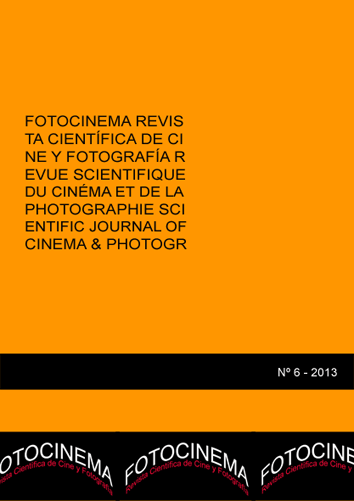L’intertexte entre le réel et l’imaginaire dans le cinéma de Wim Wenders
DOI:
https://doi.org/10.24310/Fotocinema.2013.v0i6.5908Abstract
Cet article interroge la façon dont le cinéma représente à l’écran la frontière qui existe entre le monde imaginaire des personnages et celui qu’on appelle « monde réel ». Afin de vérifier la figuration à l’écran de cette relation parfois contradictoire, voir complémentaire, on fera une brève étude du film l’Etat des Choses (1982), de Wim Wenders. Le cinéaste est né en Allemagne, en 1945. Initialement, Wenders a étudié médicine et philosophie pendant deux ans, mais, en 1967, il a changé d’avis afin de poursuivre ses études dans l’audiovisuel. A partir de là, le réalisateur s’est fait connaître comme un des représentants les plus célèbres du « nouveau cinéma allemand ». En 1978, il a été invité par Francis Ford Coppola pour participer au tournage du film Hammett. Ainsi, son cinéma a été toujours marqué par cette intersection culturelle entre l’Amérique et l’Europe. Notre objectif, dans cet article, est celui de mette en évidence les croisements du cinéma avec l’art, la relation des sujets avec l’espace, ainsi que les influences d’un sur l’autre dans les représentations cinématographiques. Notre référentiel théorique sera fondé, surtout, sur les notions de « fiction » et de « documentaire » chez François Niney. Nous espérons, à partir de cette réflexion, pouvoir comprendre plus en profondeur la façon dont Wenders travaille dans son film la métaphorisation de la lumière dans les mises en scènes, en proposant, en quelque sorte, un dialogue entre les concepts de « clarté » et d’« ombre », en ayant comme arrière-plan l’idée de fiction. Mots-clés: Fiction ; Personnages ; Réalité ; Représentation ; Wim Wenders ; L’État des Choses.This article shows the way that the cinema represents on the screen the boundaries between the imaginary world of the characters and the one that we used to call “real world”. In order to verify the representation on the screen of this contradictory relationship, sometimes complementary, we will do a brief study of the movie The State of Things (1982), of Wim Wenders. Our intention is to put in evidence the crossings of the cinema with the art, the people and the space, and their mutual influences as well. Our theoretical references will be mainly based on François Niney’s notion of “fiction” and “documentary”. We hope, from this reflection, to be able to understand more deeply the way that Wenders works in this movie the metaphors of light on the character’s “mise en scène”, proposing, somehow, a dialogue between the concepts of “clarity” and “shadow”, having as background the idea of fiction. Keywords: Fiction; Characters; Reality; Representation; Wim Wenders; L’État des Choses.
Este articulo investiga la manera quel cine representa en la grand pantalla la frontera que existe entre el mundo imaginario de los personages y este que nosotros llamamos “el mundo real”. Afin de verificar la figuratión de esta relación a veces contradictoria, a veces complementaria, nosotros haremos un breve estudio de la pelicula “El Estado de las Cosas” (1982), de Wim Wenders. El cineasta nació en Alemania en 1945. Inicialmente, Wenders estudió medicina y filosofía durante dos años, pero en 1967 cambió de opinión para continuar sus estudios en audiovisual. A partir de ahí, el director se hizo conocido como uno de los representantes más famosos del "Nuevo Cine Alemán". En 1978, fue invitado por Francis Ford Coppola para participar en el rodaje de Hammett. De esta manera, su cine siempre ha estado marcado por esta intersección cultural entre América y Europa. Nuestro objetivo, en este estudio, es de poner en evidencia les intersecciones del cine con el arte, los sujetos y el espacio, asi que las influencias del uno sobre el otro en las representationes cinematográficas. Nuestro marco teórico se basa sobre todo en los conceptos de “ficción” y “documental” de François Niney. Esperamos que, a partir de esta reflexión, podamos comprender más profundamente cómo Wenders trabaja, en su película, la metáfora de la luz en la “mise en scène” des personajes, proponiendo, en cierto sentido, un diálogo entre los conceptos de “claridad” y de “sombra”, tomando como telón de fondo la idea de ficción. Palabras clabe: Ficción; Personajes; Realidad; Representación; Wim Wenders; El estado de las cosas.
Downloads
Metrics
Downloads
Published
How to Cite
Issue
Section
License
All contents published in Fotocinema Revista científica de cine y fotografía are protected under the Creative Commons Attribution-NonCommercial-ShareAlike 4.0 International (CC BY-NC-SA 4.0) license. All about this license is available in the following link: <http://creativecommons.org/licenses/by-nc-sa/4.0>
Users can copy, use, redistribute, share and exhibit publicly as long as:
- The original source and authorship of the material are cited (Journal, Publisher and URL of the work).
- It is not used for comercial purposes.
- The existence of the license and its especifications are mentioned.
There are two sets of authors’ rights: moral and property rights. Moral rights are perpetual prerogatives, unrenounceable, not-transferable, unalienable, imprescriptible and inembargable. According to authors’ rights legislation, Fotocinema. Revista científica de cine y fotografía recognizes and respects authors moral rights, as well as the ownership of property rights, which will be transferred to University of Malaga in open access. The property rights are referred to the benefits that are gained by the use or the dissemination of works. Fotocinema. Revista científica de cine y fotografía is published in an open access form and it is exclusively licenced by any means for doing or authorising distribution, dissemination, reproduction, , adaptation, translation or arrangement of works.
Authors are responsable for obtaining the necessary permission to use copyrighted images.













13.png)




